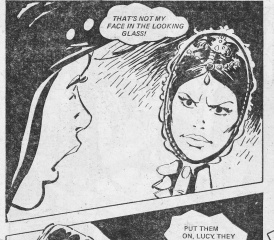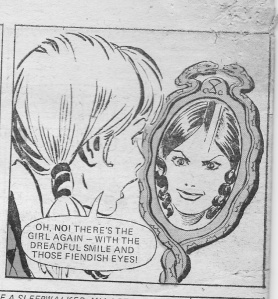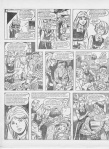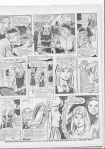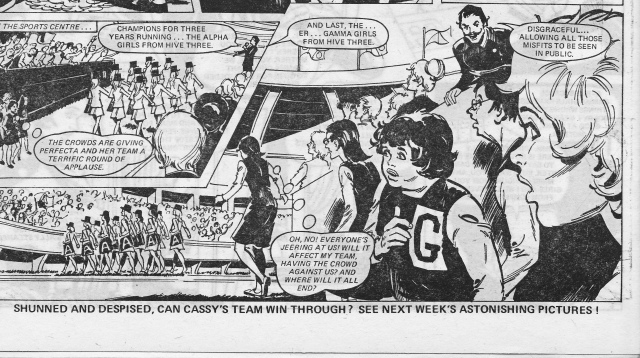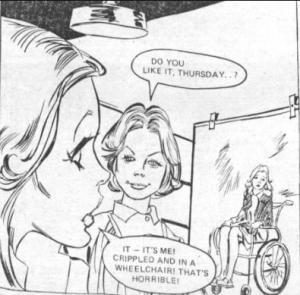There are a lot of mirrors in girls’ comics. Lots and lots of them. A new mirror-related story seemed to pop up every few months back in the 1970s and 1980s.
Yes, of course I’ve chosen these two panels to illustrate the point because they look very similar – especially appropriate as their subject is something that is expected to look identical but doesn’t. Perhaps the later story was influenced by the earlier one, perhaps the same writer penned both, perhaps both were inspired by a third source, perhaps there’s no link other than the broad subject and the artwork.
Which is rather a laboured way of pointing out something that I’m sure you all know already, which is that it’s not necessarily the case that a thing which resembles another thing is based on that thing. For example, a few years ago I wrote a Doctor Who book called ‘Winner Takes All’, in which people find themselves playing a video game for real. Now, while I’m not claiming it was the most original idea in the world, to read in reviews accusations of ‘ripping off’ either The Last Starfighter (never seen) or Only You Can Save Mankind (never read) was pretty galling, because as it happens, I don’t nick other people’s ideas. Plus where would be the fun in copying from someone else? Half the joy of being a writer is creating whole new worlds of your own!
Except… there was this one time. I was writing a comic strip. And as already discussed, comic strips and mirrors go together like ramma lamma lamma ka dingity ding da dong. For years I’d had a strong memory of a single panel from a comic strip – a girl inside a mirror, with old people around her and skeletons lying on the floor. She was trapped inside the mirror where she would age and die, and her reflection was outside, pretending to be her. I’d never managed to track down the strip, but that image haunted me. I didn’t use it in my own comic story, but I did use the idea of people being trapped inside mirrors while their reflections replaced them. Then a few years later, I finally found the strip itself! It was called The Evil Mirror (‘does exactly what it says on the tin’) and was in Girl & Dreamer in 1982. Sadly I only have two episodes, neither of which features my wonderfully scary skellington panel (although I’m 99.9% certain it’s the story the memory comes from), but I found something scarier – for me.
Below you will see a page of The Evil Mirror and a page from my comic strip. Please bear in mind that I’d read this story once, about 25 years before I wrote my story, and all I could remember was one panel and a vague premise. Please also bear in mind that the artist hadn’t – as far as I know – seen this story at all. Now tell me that the resemblance isn’t desperately spooky…

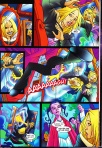 Talking of inspirations from childhood memories, my friend Tara Samms recently discovered the identity of a comic strip that had been in her mind when she wrote a pretty darn wonderful story called ‘Glass’ (Doctor Who: Short Trips). And as it happened to be from Jinty, and as I happen to have all of Jinty, here’s the first part, for Tara (I will of course remove this at the request of any copyright holder).
Talking of inspirations from childhood memories, my friend Tara Samms recently discovered the identity of a comic strip that had been in her mind when she wrote a pretty darn wonderful story called ‘Glass’ (Doctor Who: Short Trips). And as it happened to be from Jinty, and as I happen to have all of Jinty, here’s the first part, for Tara (I will of course remove this at the request of any copyright holder).
Oh, and as my all-time favourite art panel from my all-time favourite comic story happens to feature a mirror, what better way could there be to end this blog post than with Worlds Apart showing what happens if you care too much about what you look like…?

